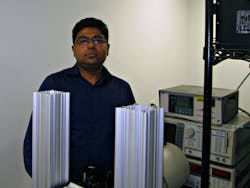DARPA funds next-generation graphene IR detector from UCF
The Defense Advanced Research Projects Agency (DARPA) awarded a $1.3 million grant to a team led by University of Central Florida (UCF; Orlando, FL) researcher Debashis Chanda to fund the development of a next-generation infrared detector that could be used in fields as varied as night vision, meteorology, and space exploration.
RELATED ARTICLE: Light pulses control graphene's electrical behavior; finding could lead to new broadband light sensors
"We are working on a novel infrared detection and imaging technology. The detection mechanism is very different than what is being used now," said Chanda, an assistant professor with joint appointments to UCF's NanoScience Technology Center and College of Optics & Photonics. The work caught the attention of the federal DARPA, which made news recently with fanciful technology like a crewless Navy drone ship, workhorse robots to lug soldiers' heavy gear, and the XS-1 space plane. DARPA is funding the UCF team's research for three and a half years.
More powerful infrared detectors that produce more detailed images--ones typically used by NASA and defense agencies--are large, expensive and can only function at ultralow temperatures. "The biggest problem is that most infrared detectors need cryogenic cooling, and in most cases you can't carry a big cooling tank with you," Chanda said. "That is a big barrier."
Chanda and associate professor Michael Leuenberger of the NTC and UCF's Department of Physics are working on an entirely new type of detector that relies on a seemingly magic material. The team plans to use a substance known as graphene. Chanda envisions an infrared detector that is small, portable, doesn't need to be cooled, and produces high-resolution images. Unlike current technologies, which can detect only one band of light, the next-gen detector would be tunable and able to see a range of bands.
"We came up with the idea that one can make graphene to strongly absorb light in the infrared domain and we showed that we can also tune the response electronically," Chanda said. "If you can take an infrared image in different spectral bands, you can extract much more information." The team intends to collaborate with defense majors such as Northrop Grumman, Lockheed Martin and St. Johns Optical Systems for integration and packaging.
SOURCE: UCF; https://today.ucf.edu/72706-2/
About the Author

Gail Overton
Senior Editor (2004-2020)
Gail has more than 30 years of engineering, marketing, product management, and editorial experience in the photonics and optical communications industry. Before joining the staff at Laser Focus World in 2004, she held many product management and product marketing roles in the fiber-optics industry, most notably at Hughes (El Segundo, CA), GTE Labs (Waltham, MA), Corning (Corning, NY), Photon Kinetics (Beaverton, OR), and Newport Corporation (Irvine, CA). During her marketing career, Gail published articles in WDM Solutions and Sensors magazine and traveled internationally to conduct product and sales training. Gail received her BS degree in physics, with an emphasis in optics, from San Diego State University in San Diego, CA in May 1986.
